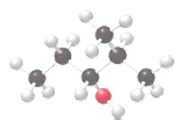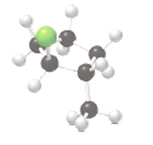
EBK GENERAL, ORGANIC, & BIOLOGICAL CHEM
3rd Edition
ISBN: 9781259298424
Author: SMITH
Publisher: VST
expand_more
expand_more
format_list_bulleted
Question
Chapter 14, Problem 14.37P
Interpretation Introduction
(a)
Interpretation:
The name of the following molecule which is depicted in the ball-and-stick model should be determined.

Concept Introduction:
Name of the compound can be assigned according to below rule:
First, identify the number of carbon atoms present in the longest continuous chain, and then identify the
Interpretation Introduction
(b)
Interpretation:
The name of the following molecule which is depicted in the ball-and-stick model should be determined.

Concept Introduction:
Name of the compound can be assigned according to below rule:
First, identify the number of carbon atoms present in chain, and then identify the function group if present in the given compound.
Expert Solution & Answer
Want to see the full answer?
Check out a sample textbook solution
Students have asked these similar questions
What is the [OH⁻] of a 1.80 M solution of pyridine (C₅H₅N, Kb = 1.70 × 10⁻⁹)?
What is the percent ionization in a 0.260 M solution of formic acid (HCOOH) (Ka = 1.78 × 10⁻⁴)?
Determine the pH of solution of HC3H5O2 By constructing an ICE table writing the equilibrium constant expression, and using this information to determine the pH. The Ka of HC3H5O2 is 1.3 x 10-5
Chapter 14 Solutions
EBK GENERAL, ORGANIC, & BIOLOGICAL CHEM
Ch. 14.1 - Prob. 14.1PCh. 14.2 - Prob. 14.2PCh. 14.2 - Classify each hydroxyl group in sorbitol as 1°,...Ch. 14.2 - Prob. 14.4PCh. 14.2 - Prob. 14.5PCh. 14.3 - Prob. 14.6PCh. 14.3 - Give the structure corresponding to each name a....Ch. 14.5 - Draw the products formed when each alcohol is...Ch. 14.5 - Prob. 14.9PCh. 14.5 - Prob. 14.10P
Ch. 14.5 - Prob. 14.11PCh. 14.6 - Prob. 14.12PCh. 14.6 - Prob. 14.13PCh. 14.7 - Prob. 14.14PCh. 14.7 - Prob. 14.15PCh. 14.7 - Prob. 14.16PCh. 14.7 - Prob. 14.17PCh. 14.8 - (a) Translate the hall and stick model of...Ch. 14.8 - Prob. 14.19PCh. 14.9 - Prob. 14.20PCh. 14.9 - Prob. 14.21PCh. 14.9 - Prob. 14.22PCh. 14.9 - Prob. 14.23PCh. 14.9 - Prob. 14.24PCh. 14.9 - Prob. 14.25PCh. 14.10 - Prob. 14.26PCh. 14.10 - Prob. 14.27PCh. 14.10 - Prob. 14.28PCh. 14 - Prob. 14.29PCh. 14 - Prob. 14.30PCh. 14 - Prob. 14.31PCh. 14 - Classify each halide hi A as 1°, 2°, or 3°. A is a...Ch. 14 - Prob. 14.33PCh. 14 - Draw the structure of a molecule that fits each...Ch. 14 - Draw the structure of the six constitutional...Ch. 14 - Draw the structure of the four constitutional...Ch. 14 - Prob. 14.37PCh. 14 - Prob. 14.38PCh. 14 - Prob. 14.39PCh. 14 - Answer each question about alcohol B. Draw a...Ch. 14 - Prob. 14.41PCh. 14 - Give the IUAPC name for each alcohol.Ch. 14 - Prob. 14.43PCh. 14 - Prob. 14.44PCh. 14 - Prob. 14.45PCh. 14 - Prob. 14.46PCh. 14 - Draw the structures and give the IUPAC names for...Ch. 14 - Prob. 14.48PCh. 14 - Prob. 14.49PCh. 14 - Prob. 14.50PCh. 14 - Give the structure corresponding to each IUPAC...Ch. 14 - Give the structure corresponding to each IUPAC...Ch. 14 - Which compound in each pair has the higher boiling...Ch. 14 - Rank the compounds in order of increasing melting...Ch. 14 - Rank the following compounds in order of...Ch. 14 - Rank the following compounds in order of...Ch. 14 - Prob. 14.57PCh. 14 - Prob. 14.58PCh. 14 - Prob. 14.59PCh. 14 - Prob. 14.60PCh. 14 - Prob. 14.61PCh. 14 - Prob. 14.62PCh. 14 - Prob. 14.63PCh. 14 - Prob. 14.64PCh. 14 - Prob. 14.65PCh. 14 - Prob. 14.66PCh. 14 - Prob. 14.67PCh. 14 - Prob. 14.68PCh. 14 - Prob. 14.69PCh. 14 - Prob. 14.70PCh. 14 - Prob. 14.71PCh. 14 - Prob. 14.72PCh. 14 - Prob. 14.73PCh. 14 - Prob. 14.74PCh. 14 - Prob. 14.75PCh. 14 - Prob. 14.76PCh. 14 - Prob. 14.77PCh. 14 - Prob. 14.78PCh. 14 - Prob. 14.79PCh. 14 - Prob. 14.80PCh. 14 - Prob. 14.81PCh. 14 - Prob. 14.82PCh. 14 - Prob. 14.83PCh. 14 - Prob. 14.84PCh. 14 - Prob. 14.85PCh. 14 - Prob. 14.86PCh. 14 - With reference to the halogenated organic...Ch. 14 - Prob. 14.88PCh. 14 - Prob. 14.89PCh. 14 - Prob. 14.90PCh. 14 - Write out the chemical reaction that occurs when a...Ch. 14 - Prob. 14.92PCh. 14 - Prob. 14.93PCh. 14 - Lactic acid [CH3CH(OH)CO2H] gives sour milk its...Ch. 14 - Prob. 14.95PCh. 14 - Prob. 14.96PCh. 14 - Prob. 14.97PCh. 14 - Prob. 14.98PCh. 14 - Prob. 14.99PCh. 14 - Answer the following questions about alcohol B....Ch. 14 - Prob. 14.101CPCh. 14 - Dehydration of alcohol C forms two products of...
Knowledge Booster
Learn more about
Need a deep-dive on the concept behind this application? Look no further. Learn more about this topic, chemistry and related others by exploring similar questions and additional content below.Similar questions
- Determine if the following salt is neutral, acidic or basic. If acidic or basic, write the appropriate equilibrium equation for the acid or base that exists when the salt is dissolved in aqueous solution. If neutral, simply write only NR. Be sure to include the proper phases for all species within the reaction LiNO3arrow_forwardAn unknown weak acid with a concentration of 0.410 M has a pH of 5.600. What is the Ka of the weak acid?arrow_forward(racemic) 19.84 Using your reaction roadmaps as a guide, show how to convert 2-oxepanone and ethanol into 1-cyclopentenecarbaldehyde. You must use 2-oxepanone as the source of all carbon atoms in the target molecule. Show all reagents and all molecules synthesized along the way. & + EtOH H 2-Oxepanone 1-Cyclopentenecarbaldehydearrow_forward
- R₂ R₁ R₁ a R Rg Nu R₂ Rg R₁ R R₁₂ R3 R R Nu enolate forming R₁ R B-Alkylated carbonyl species or amines Cyclic B-Ketoester R₁₁ HOB R R₁B R R₁₂ B-Hydroxy carbonyl R diester R2 R3 R₁ RB OR R₂ 0 aB-Unsaturated carbonyl NaOR Aldol HOR reaction 1) LDA 2) R-X 3) H₂O/H₂O ketone, aldehyde 1) 2°-amine 2) acid chloride 3) H₂O'/H₂O 0 O R₁ R₁ R R₁ R₁₂ Alkylated a-carbon R₁ H.C R₁ H.C Alkylated methyl ketone acetoacetic ester B-Ketoester ester R₁ HO R₂ R B-Dicarbonyl HO Alkylated carboxylic acid malonic ester Write the reagents required to bring about each reaction next to the arrows shown. Next, record any regiochemistry or stereochemistry considerations relevant to the reaction. You should also record any key aspects of the mechanism, such as forma- tion of an important intermediate, as a helpful reminder. You may want to keep track of all reactions that make carbon-carbon bonds, because these help you build large molecules from smaller fragments. This especially applies to the reactions in…arrow_forwardProvide the reasonable steps to achieve the following synthesis.arrow_forwardIdentify which compound is more acidic. Justify your choice.arrow_forward
- Provide the reasonable steps to achieve the following synthesis.arrow_forwardWhen anisole is treated with excess bromine, the reaction gives a product which shows two singlets in 1H NMR. Draw the product.arrow_forward(ii) Draw a reasonable mechanism for the following reaction: CI NaOH heat OH (hint: SNAr Reaction) :arrow_forward
arrow_back_ios
SEE MORE QUESTIONS
arrow_forward_ios
Recommended textbooks for you
 Introductory Chemistry: An Active Learning Approa...ChemistryISBN:9781305079250Author:Mark S. Cracolice, Ed PetersPublisher:Cengage Learning
Introductory Chemistry: An Active Learning Approa...ChemistryISBN:9781305079250Author:Mark S. Cracolice, Ed PetersPublisher:Cengage Learning Chemistry: Principles and PracticeChemistryISBN:9780534420123Author:Daniel L. Reger, Scott R. Goode, David W. Ball, Edward MercerPublisher:Cengage Learning
Chemistry: Principles and PracticeChemistryISBN:9780534420123Author:Daniel L. Reger, Scott R. Goode, David W. Ball, Edward MercerPublisher:Cengage Learning Chemistry for Today: General, Organic, and Bioche...ChemistryISBN:9781305960060Author:Spencer L. Seager, Michael R. Slabaugh, Maren S. HansenPublisher:Cengage Learning
Chemistry for Today: General, Organic, and Bioche...ChemistryISBN:9781305960060Author:Spencer L. Seager, Michael R. Slabaugh, Maren S. HansenPublisher:Cengage Learning

Introductory Chemistry: An Active Learning Approa...
Chemistry
ISBN:9781305079250
Author:Mark S. Cracolice, Ed Peters
Publisher:Cengage Learning

Chemistry: Principles and Practice
Chemistry
ISBN:9780534420123
Author:Daniel L. Reger, Scott R. Goode, David W. Ball, Edward Mercer
Publisher:Cengage Learning

Chemistry for Today: General, Organic, and Bioche...
Chemistry
ISBN:9781305960060
Author:Spencer L. Seager, Michael R. Slabaugh, Maren S. Hansen
Publisher:Cengage Learning

07 Physical Properties of Organic Compounds; Author: Mindset;https://www.youtube.com/watch?v=UjlSgwq4w6U;License: Standard YouTube License, CC-BY